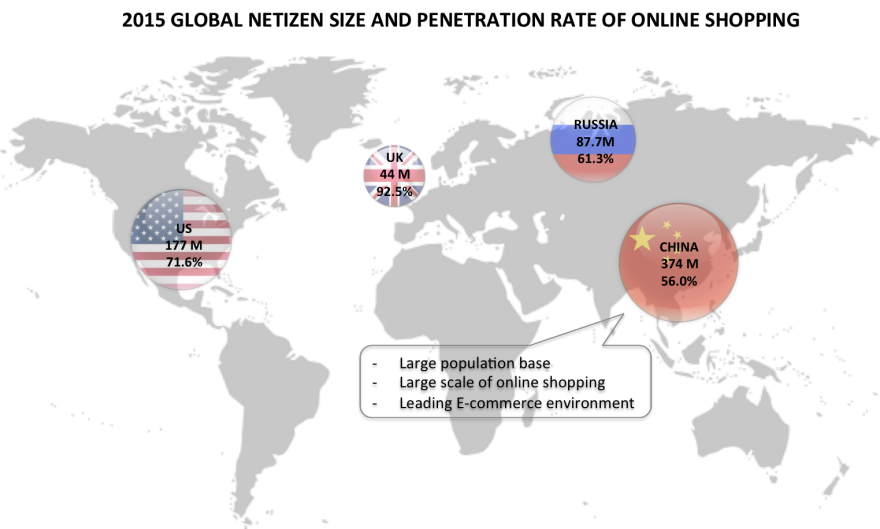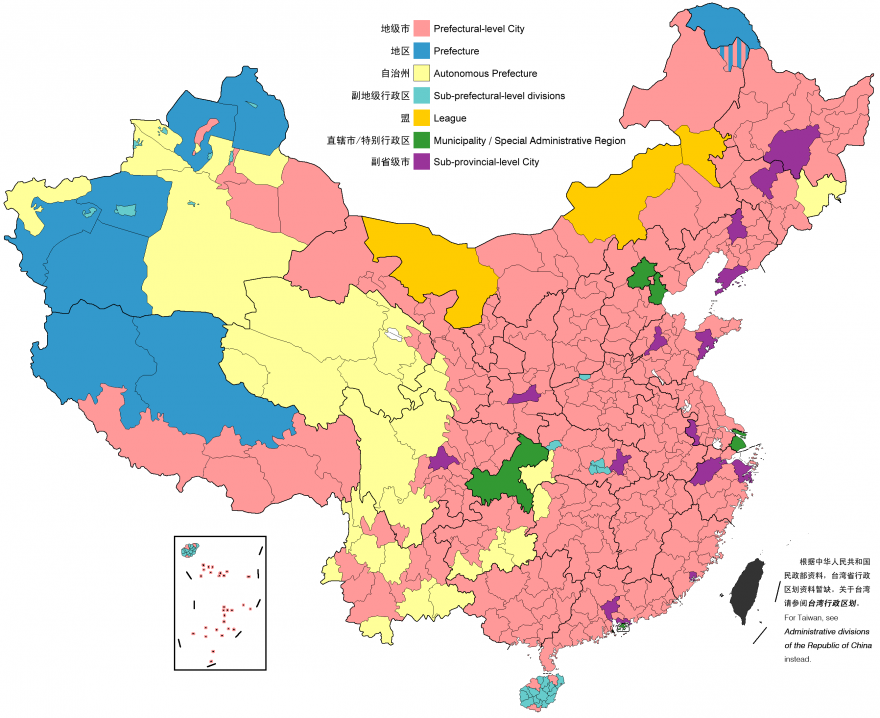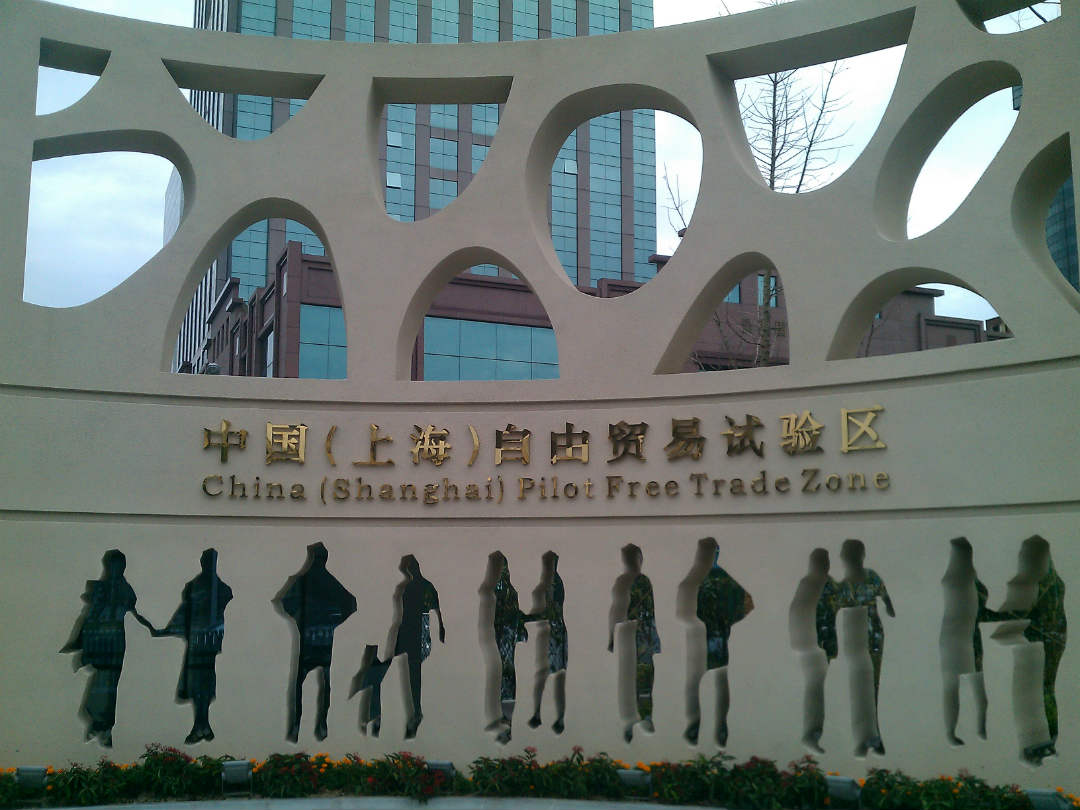Why China E-commerce Goes So Fast?
All of us are very well aware of the magnitude of the Chinese online market and, although it is currently the largest Ecommerce market in the world, it is also the most changeable one.
From 2 Open, we want to enable your approach to China giving you some practical guidelines about the current state of Ecommerce in China.
Understanding what is happening in China needs time and a constant willingness to learn: sometimes its fast evolution makes it hard to follow the new trends, other times foreigners just find an incomplete analysis.
According to the analysis report done by Data Center of China Internet -from now on DCCI-, China has currently taken the first place as the greatest E-commerce country in the world, while the online shopping penetration rate of China is in the second place after United States.

The result of China E-commerce indicates the Chinese economic keystone in recent years, also their development trend of commerce in the future.
As a result, in 2 Open we strongly believe there are more opportunities in the future for E-commerce development.
There are a range of factors we should take into consideration in our approach to the country:
E-commerce market is booming, due to the existence of multiple factors which stimulate the development
In 2015 in China, penetration rate of online shopping reached to 56%. This means there is a huge space to further development comparing with the most-developed countries, and a great opportunity to companies coming to China.
Although there are many factors which are promoting the trend, the main reasons can be summarized in a set of main points:
- Population: Until June 2015, China has 668 million netizens, 594 million mobile phone users and 374 million online shoppers. This leads us to a great size of online shoppers and a strong demand in domestic market.
- Policy: China and its Government have adapted many strategies and measures to promote the E-commerce development. It is a fact that the confluence of two forces have achieved incredible results in recent times.
- Technology: The mature E-commerce relating technologies facilitates the promotion of various industries, especially those related to the Big Data, Internet security, Online payment and Mobile technology. A niche market that is worthy.
- Enterprise: Internet companies have finally joined and distribute to the whole industry, so the result has been that most of the traditional E-commerce companies are transforming to the New Model. Thanks to it, the industry chains of BAT (Baidu, Alibaba, Tencent) cover a large area in China and it is expected to keep growing in future.
- Ecological Integration: The whole industry is getting into a mixture between online and offline industry. Take a look to Alibabas example: they have relied on the industry chain of E-commerce to integrate video, games, travel, finance and other fields into a complete unity. That is the future!
- Basic Infrastructure: Internet infrastructure develops rapidly, especially the Mobile Internet. But also 4G is changing the scene: in the end of July 2015, China 4G accumulated more than 250 million users and 4G base stations were over 1.53 million, of which the construction of TD-LTE base stations were over 1 million. Nowadays, 4G smart phone has already accounted for 82.7% of the domestic smartphone market and seems there is still a gap to fill.
Accommodating to the human-oriented strategy, the E-commerce marketing gets a standout result
With the diversification of E-commerce, the elements influence on the marketing result also became complicated, thus the marketing KPIs should be clear for the marketing themes and goals.
E-commerce marketing has changed from past into a new model of advertising, which is accommodated to the Internet users.
The Model of procedural purchase facilitates the result of advertising, optimizing the convention, and achieves 3 times of ROI:
- The user is the focus: Advertisement position of E-commerce marketing is transforming into human-oriented.
- Procedural purchase is pushing E-commerce marketing into OTG (On-The-Go) model.

Rapid growth of mobile terminal and Big Data brings more commercial values
Now in China Ecommerce market, users, marketing and advertisement investors are in favor of mobile terminal. With the development of mobile technology, the traditional business was greatly impacted.
¿The result? Big Data sharing connects user, product and service together; each data channel communicate with others can release a higher-value data stream.
Vigorously develop of the “festival event”
In recent years, the festival promotion has become an important way of arresting customers. Since November 2011, it has already turned into a battle for the Chinese leading E-commerce companies.
But also the advantage of big data sharing and innovated technology did a tremendous support in the precise marketing and advertisement.
Take Tmall as an example: in 2015, the turnover of Tmall reached ¥57.1 billion just in one day. A huge amount that can still increase.
The tremendous transformation that China lives, cannot be understood without experiencing it by firsthand.
From 2 Open, we have a global perspective and the expertise any company thinking on coming to China needs to develop its business in the country.
If you are looking to take advantage of Chinese Ecommerce, we will be happy to help you.
This article has been edited by Paula Vicuña, from 2 Open
How to use Tencent Penguin Intelligence in your approach to the Chinese market?
Are you looking for the latest news of Tech innovation in China?
The goal of this article is to shed some lights of why Penguin Intelligence is a work-tool to keep in mind on your approach to China.
Penguin Intelligence is the official data platform from Tencent Technology
Tencent Research Organization works such as a professional organization which publishes in-depth reports about the Chinese mobile ecosystem.
Penguin Intelligence performs research and advocacy concerning hot-topics. It also studies markets, trends and best emerging practices.
Their work is founded on a rigorous thorough understanding of every Industry Focus, Sector Dynamics, Case Studies, Data Analysis and Macro environment.
Penguin Intelligence is constantly optimizing the analytical model
Penguin Intelligence is your best choice if you want to figure out what is happening in Chinese Internet Industry. Unfortunately, their business analysis and reports are only available in Chinese for the moment.
Penguin Intelligence also counts with three original sub-columns:
- Penguin Investigation
- Penguin Analysis
- Penguin Portfolio
In addition, Penguin Intelligence includes an Open Platform, which is a huge cohesion of all wisdom from China technological business.
What will you find in Penguin Intelligence?
As we have mention above, Penguin Intelligence contains a full variety of reports, infographics and data.
There are more than thirty valuable Business research reports, hundreds of in-depth analysis reports that have been already published and the Platform keeps growing every day.
The influence of these reports / studies has touched up multiple areas of Internet and traditional industries.
Due to its importance, Penguin Intelligence currently enjoys high reputation and credibility in Governments and Enterprises.
To illustrate the kind of searches which can be done, from 2 OPEN we have compiled a brief list of some of the most striking examples that you can find on the Platform:
- In-depth reports and fresh data about Tencent ecosystem; WeChat public accounts: What type of articles get the most attention from readers?
- Many infographics and graphs about mobile ecosystem in China; iPhoneS sales in China
- Data about digital marketing customer behavior; Do customers prefer hongbao or discounts?
Relying on Tencent, Penguin Intelligence contains a large user base and massive data advantage of products in multiple fields:
- Social networking application: WeChat (Most-used application in China)
- Social networking service: Qzone, Tencent microblog, Tencent Video
- Instant messengers: QQ, QQ International
- Online payment system: TenPay (which is similar to Paypal)
- Cloud storage service: Tencent Weiyun
- Own search engine: Soso.com
- Media player: QQ player, QQ Music, KuGou Music, KuWo Music
- C2C auction site: paipai.com (now merged with JD.com)

The huge scale of Tencent Data is the cornerstone of Penguin Intelligence ability to mine and analyze data, and serving professional market insights and industry reports.
Do you want to discover a little more of Penguin Intelligence?
As a Digital Marketing and Sales Agency, from 2 OPEN we often suggest you to contact us for a deeper understanding of all knowledge Penguin hosts.
Do not forget to subscribe to our Newsletter to receive some special information about China!
This article has been edited by Paula Vicuña from 2 Open.
How to take advantage of the latest E Commerce revolution? U-Commerce trend
Nowadays, we all are very well aware of the importance of Ecommerce on current business.
E-Commerce has been a great revolution for companies and customers, helping the exchange of goods and services without geographical barriers via Internet.
With most of famous brands selling via e-Commerce and the development of B2B, B2C and C2C markets, the last revolution has come to stay: the Mobile Commerce or better known, M-Commerce.
But, What do we mean when we talk about M-Commerce?
The increase of the usage of smartphones and tablets and the growth of its capabilities, lead to a higher percentage of the population using technological devices to purchase their goods or services. According to the increase of the demand and in order to take advantage of this new trend, Companies have already identified the need to adapt their ways of selling to the portable devices.
China, the biggest consumer via E-Commerce country and a technologically advanced market, is a good example to put into consideration: the Retail and C2C ecommerce sales have grown from the 9% to the 55.5% since 2013.
This information show us that nowadays, most of the C2C Chinese customers prefer to use the mobile device than their PCs or laptops.

Omnichannel Marketing, What´s its purpose?
At the same time, to E-Commerce has joined a new feature: the existence of the multichannel approach to sales, or “Omnichannel”.
This channel is looking for the continuous shopping experience of each customer. The aim of the Omnichannel Marketing is offering a continuous experience to the user, independent from the device or channel chosen.
In practice, this leads to a complete integration between phones, tablets and computers and it requires the combination of an anthropological and technological strategy in approaching the users in a smarter way.
From the combination of all this, arises the U-Commerce concept.
What is U-Commerce or Ubiquitous Commerce?
If we simplify, we would say that we are talking about U-Commerce when E-Commerce is based in the customer experience.
The user must be in the center of all Companies’ strategies. Those Companies using U-Commerce must be able to provide personalized service to their clients from the information they get from mobile devices and PC-s.
The keys are: customizing and navigation experience created in cooperation with the User.

How is this possible?
It is obvious that the technological development is responsible for this change and makes necessary to pay attention to the internal customer databases.
Companies must try to find out common interests between potential clients who visit their EShops, considering each potential customer as unique and with their own preferences and priorities.
Efforts should be directed to avoid high rates of leads who finally give up navigating in the last purchasing phase, and reach around 60-70%.
This is the crucial reason for companies to invest their efforts and resources in understanding the customers and their behavior: to boost sales.
A lack of privacy: How companies use data?
U-Commerce uses personal information in order to provide a personalized service. A big number of customers feel disrespectful that a company can get their personal information and manage it as they want. Therefore, we must emphasize the benefits that the data can bring to the user and treat delicately the data we are able to collect.
Times are changing and the number of E-Commerce consumers is increasing exponentially and also the M-Commerce is growing very fast.
It’s important to face it and consider user’s needs, their preferences and desires. So companies must rechange strategies and adapt to the new eCommerce “revolution”.
Are you thinking about improving the user experience and exploit the advantages that the use of Online Marketing gives us?
Come to us, We are expecting you!
This article has been edited by Paula Vicuña, from 2 OPEN.
Tencent and JD Launch Targeted Brand Advertising on WeChat
From the association of Tencent –owner of the biggest social platforms in China- and JD.com –the leading online direct sales company in the country-, has emerged a new conception of Marketing and Brand Advertising.
In 2016 in Beijing, both released a plan based on Ecommerce marketing service called “J&T Plan”.
The new policy was aimed to provide a tool to accurate a better portrait of the potential user, and improve the interaction with the consumer.
As a result, users data has become extremely valuable for any company:
Knowledge is power, more than ever.
What are their main Goals?

The aspiration of Tencent and JD.com partnership has been to provide a pleasant and high quality service to their users.
To reach its purpose, they have focused on three main objectives to strength its business on mobile and Internet, such as:
- Mobile access points
- Traffic support
- Ecommerce activities
Their desire to turn the user into the protagonist of the new Marketing, has launched a new approach based on three main ideas:
- Multi-dimensional user insight
- Effectiveness analysis
- Precision target audience
What do they want in Return?

Not only a commitment to the future and an advantage over its competitors, their relationship also give them some specific advantages:
JD.com obtains a stake in Yixun, PaiPai C2C marketplace businesses, logistics personnel and assets and QQ Wanggou B2C.
On the other hand, Tencent will offer level one access points in Weixin and Mobile QQ and support from other key platforms to JD.com.
In order to provide a better online shopping experience, they will also work together on providing solutions to online payment services and an overall digital marketing solutions.
If you are thinking on improving your company services, before starting a Business and Marketing Plan you should take in consideration some basic recomendations:
Build a well-aimed portrait of the users, improve brand experience with the client, and enhance technological tools to achieve it, have become the three key factors to consider on any approach to potential customers, and the best guarantee for the future of your company.
From 2 OPEN we have conformed a team capable of responding to new challenges and specialized on Business Intelligence. We can help you to deal with the new Marketing and Ecommerce trends.
Come with us. Together we will reach your company goals.
This article was edited by Paula Vicuña from 2 OPEN.
How can foreign SMEs be competitive in China?
Most western economies enjoy an abundant offer of qualified talent that proportionally lacks in China. Nevertheless, China’s macroeconomic situation is starting to increase the demand of qualified talent, and more importantly, it is starting to value it more, rewarding it in ways that we do not often see in other economies, or at least not back in Europe.
All of this creates a reality of scarcity due to the fact that an increasing amount of knowledge is being accumulated in just a few hands and results in a division between talent knowledge and labor knowledge. When competing in the knowledge market, being capable of assembling a talented team is the key difference that will give you the competitive advantage.
Big companies and well-funded start-ups are very aware of this fact, they put a lot of effort and invest a lot of money on the recruitment of talented personal.

So what about small and medium-sized enterprises then? What can they do in order to be competitive as employers in the Chinese market? And what can they do when big foreign companies tend to concentrate on tier 1 cities candidates that have good English communication skills?
The questions mentioned above have very difficult answers. Truth be told, most foreign SMEs in China have no chance of succeeding, or being competitive, as an employers in such a shark tank, that is, tier 1 cities. Looking at it from a market perspective, tier 1 cities are a horrible place to build and sustain a capable and long lasting team.
Probably, trying to move out of a tier 1 city is the first advice for foreign SMEs. Even if the idea of living in a truly Chinese city, without Starbucks or McDonalds hanging around, frightens you, it will make it a lot easier for you to grow your company. The only real issue here is that clients and movement is mainly happening around cities like Shanghai and Beijing and less in other cities, nevertheless there are plenty of other means through which you can get clients. At the end of the day there is no perfect place to grow your business without a few drawbacks, maybe once your company has grown enough you could consider moving to a tier 1 city.

It is worth mentioning, however, that finding clients is the first stage of every business, that initial stage where it is considered a top priority. With its years of experience, 2 Open has long surpassed that, right now, finding clients is for us only a secondary priority. We are now focusing in process excellence, in nurturing scalable ways of working that continuously add value to our clients, keeping a stable and financially balanced organization that will last for many… many years…
This is one of the main reasons why our company does not only have offices in Weihai and Cáceres, but is based in Shanghai and Madrid. We are constantly making changes in order to maintain competitive advantage, we have already been in the market for 3 years and we are preparing for the upcoming 30. We strive in order to offer reliable, sustainable and long term oriented solutions that add value to China as a whole, not only its tier 1 cities
Probably you do not think that moving to tier 3 in order to assembly a powerful team is something you would like to do yourself. Well, do not worry about it. If you want to know more about how we work and how we help, engage, support, and lead our clients to succeed, contact us. We DO Open. Do you?
This article was edited by Andres Arroyo Olson from 2 Open.
2Open at Territorio Creativo: China Business Overview
On Friday the 5th of February Luis Salvador Galán, the CEO of 2Open, went to give a speech to the well-known Spanish marketing consulting agency called “Territorio Creativo” (https://www.territoriocreativo.es/en/). Territorio Creativo was founded back in 1997 and it has had a huge development ever since. In 2005 its blog (TCBlog) was brought to life which later became to be one of the most influential blogs in the field, this helped and boosted the company to the highest relevant positions in the area. As for 2009, the company decided to focus more on Social Media Marketing and nowadays they operate in many different locations around the globe and have more than 100 employees.
Every Friday they organize a meeting during a breakfast session in which an expert shares experiences, expertise and knowledge with all the company’s members, this is usually held in the Madrid and Barcelona offices. They call it TcDesayunos. Luis S. Galán decided to share his Chinese experiences in the Digital Field and commentated on his personal vision about China’s landscape. Although he could have spoken about the development and best practices of 2Open, he opted for another approach and instead took the opportunity to share business experiences and receive brilliant ideas and comments from the audience.

The talk focused mainly on creativity, differences in politics, and the development of China in certain digital areas. The relation and contrast between creativity and freedom were discussed as well as advantages and disadvantages between the Spanish political system and the Chinese one. The huge development of mobile use and e-commerce in China was also a topic of discussion, since it has had a considerable growth in the past few years. The aim of this talk was mainly to give the Spanish audience a grasp of what the Chinese business environment looks like and where it is heading so they could get an idea of the so called “Chinese dream”.
If you wish to have a look at the article of Territorio Creativo about the session, and if you speak Spanish, here is the link to it: https://www.territoriocreativo.es/etc/2016/02/china-emperadora-del-ecommerce.html
This article was edited by Andres Arroyo Olson from 2Open.
General situation of cross-border e-commerce in China
General situation of cross-border e-commerce in China
2014 is called by many the year of beginning of cross-border e-commerce in China. Traditional retailers, domestic and oversea e-commerce giants, start-ups, logistic service providers and distributors have all joined this battle trying to get a share of the cake.
No doubt this is a time of challenges and opportunities, getting to know the current situation is helpful to forecast a slice of the future.
So what do we know about the positive factors that lead the cross-border e-commerce in China continue to grow?
A window period of dividend policy
With the official documents N°56 and N°57, issued by General Administration of Customs of People’s Republic of China (PRC), the cross-border e-commerce has finally been authorized at 2014 in China. The”6+1” testing cities (Shanghai, Chongqing, Hangzhou, Ningbo, Zhengzhou, Guangzhou, Shenzhen) have since then enjoyed the tax reduction for cross-border e-commerce, which means products purchased through cross-border e-commerce channel will only be charged with personal postal articles tax, instead of the “customs + added-value tax + consumption duty” for common import trade. Thanks to policy incentives, which is aiming at bringing the oversea consumption back to mainland China, cross-border e-commerce has witnessed rapid growth.
Huge potential of customer needs
Nielsen recently issued the China’s E-commerce Industry Development and Hangzhou Index White Paper, suggesting that “affluent and well-educated young people make up the majority of cross-border online shoppers and the cross-border online shopping features at low frequency and higher spending per order compared to domestic online shopping”.
According to the statistics from General Administration of Customs and Research Center of China’s e-commerce, the size of transactions and the user’s volume have tremendously increased in these couple of years. The size of transactions grows from ten billion to hundred billion and some predictions show that it will reach trillion level in 2018.
Not everything is favorable, we are still facing many challenges
The tax reduction policy will not last for long because the government has to find a balance between the traditional trade and the cross-border e-commerce. The uncertainty of policy may affect every segment of cross-border e-commerce in China.
The immaturity of logistics and customs clearance system, the slow process makes the after sales services can’t be guaranteed. In the future shopping experience needs to be bettered with a smoother customs’ process.
The possibility of directly signing a contract between a foreign brand and a Chinese cross-border e-commerce platform is remote, therefore cross-border e-commerce platforms often use combined supply chain, which is unstable and will lead the price of product hard to be controlled. The one has the ability to get through each segment on the supply chain will be the first to take the market.
Currently, not a single cross-border e-commerce platform is widely accepted by customers, major player and start-ups are basically at the same starting line. The early stage development relies more on policies, lower price, richness of products, but as time goes, the competition will be back to the retail level – brand, supply chain and customer services.
We do still have the possibility to change the game, don’t you think?
Check the original Chinese article here
References:








